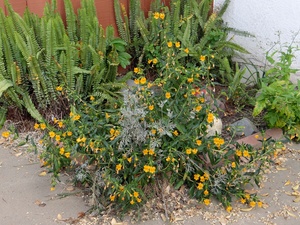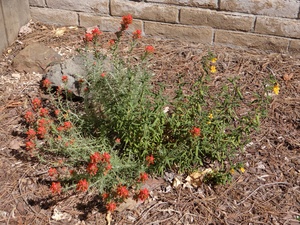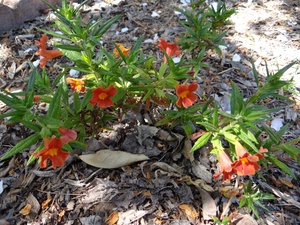Monkeyflowers are flowering plants in several genera of the lopseed family (Phrymaceae). Some are herbaceous annuals or perennials, while others are shrubs. Most of them prefer to grow in shaded spots or with constant access to water. Monkeyflower leaves are a favorite food for the caterpillars of the local variable checkerspot and common buckeye butterflies.
Monkeyflowers are ranked 1 out of 10 on the Ogren Plant Allergy Scale, indicating that they are the safest possible plants for hay fever sufferers.
Native to Woodland
Five species of monkeyflowers are native to Woodland.
 This photo shows the typical wild form and color of sticky monkeyflowers in the Woodland area. Photo by queerbychoice.The Sticky Monkeyflower (Diplacus aurantiacus) is the monkeyflower most commonly planted in gardens. It is native to the southeastern half or so of Woodland. It is a shrub that can grow four to five feet tall and equally wide, prefers partial shade to mostly shade, and does not need much water. It typically has orange flowers, although very closely related species from other parts of California have other flower colors, and the various species have been hybridized to create cultivars with even more different flower colors. Its name refers to the fact that its foliage tends to be slightly sticky with sap, although the stickiness is not very noticeable unless you're specifically trying to notice it. The Sticky Monkeyflower is a common host plant for hemiparasitic paintbrush plants (Castilleja spp.)
This photo shows the typical wild form and color of sticky monkeyflowers in the Woodland area. Photo by queerbychoice.The Sticky Monkeyflower (Diplacus aurantiacus) is the monkeyflower most commonly planted in gardens. It is native to the southeastern half or so of Woodland. It is a shrub that can grow four to five feet tall and equally wide, prefers partial shade to mostly shade, and does not need much water. It typically has orange flowers, although very closely related species from other parts of California have other flower colors, and the various species have been hybridized to create cultivars with even more different flower colors. Its name refers to the fact that its foliage tends to be slightly sticky with sap, although the stickiness is not very noticeable unless you're specifically trying to notice it. The Sticky Monkeyflower is a common host plant for hemiparasitic paintbrush plants (Castilleja spp.)
 The sticky monkeyflower (Diplacus aurantiacus) with pale yellow-orange flowers on the right is serving as the host plant for a hemiparasitic Texas paintbrush (Castilleja foliolosa), which is producing the dark red-orange flowers on the left. The parasitic plant can often grow larger than its host. Photo by queerbychoice.
The sticky monkeyflower (Diplacus aurantiacus) with pale yellow-orange flowers on the right is serving as the host plant for a hemiparasitic Texas paintbrush (Castilleja foliolosa), which is producing the dark red-orange flowers on the left. The parasitic plant can often grow larger than its host. Photo by queerbychoice. Diplacus 'Jelly Bean Cinnamon' is a hybrid cultivar bred from Diplacus aurantiacus (native to Woodland) and Diplacus puniceus (a closely related species native to Southern California). Photo by queerbychoice.
Diplacus 'Jelly Bean Cinnamon' is a hybrid cultivar bred from Diplacus aurantiacus (native to Woodland) and Diplacus puniceus (a closely related species native to Southern California). Photo by queerbychoice.
The Tricolor Monkeyflower (Diplacus tricolor) is a six-inch-tall annual herb native to all parts of Woodland. Its flowers are predominantly pink, with yellow, white, and deep red markings at the throat. It is always a wetlands plant, usually growing in seasonal wetlands such as vernal pools.
 Seep monkeyflowers (Erythranthe guttata) grow faster and larger if they receive more water. This is a single seep monkeyflower plant that grew in a nearly year-round mud puddle. Photo by queerbychoice.The Seep Monkeyflower (Erythranthe guttata) is an annual or perennial herb native to all parts of Woodland. It has yellow flowers with deep red dots around the throat. It is always a wetlands plant, usually growing along streams or seeps, and sometimes even as an aquatic, floating plant in water that is up to two feet deep. It can grow as much as five feet tall when growing in water but is more commonly seen at about one foot tall in muddy seeps. It is ideal for filtering water in small homemade ponds, and it can also be easily grown in pots that do not have any drainage holes, because it does not need any drainage and is better off never drying out.
Seep monkeyflowers (Erythranthe guttata) grow faster and larger if they receive more water. This is a single seep monkeyflower plant that grew in a nearly year-round mud puddle. Photo by queerbychoice.The Seep Monkeyflower (Erythranthe guttata) is an annual or perennial herb native to all parts of Woodland. It has yellow flowers with deep red dots around the throat. It is always a wetlands plant, usually growing along streams or seeps, and sometimes even as an aquatic, floating plant in water that is up to two feet deep. It can grow as much as five feet tall when growing in water but is more commonly seen at about one foot tall in muddy seeps. It is ideal for filtering water in small homemade ponds, and it can also be easily grown in pots that do not have any drainage holes, because it does not need any drainage and is better off never drying out.
The Broad-Toothed Monkeyflower (Erythranthe latidens) is a one-foot-tall annual herb native to all parts of Woodland. Its flowers can be pink, white, or yellow. It is always a wetlands plant, usually growing in seasonal wetlands such as vernal pools.
The Snouted Monkeyflower (Mimetanthe pilosa) is a one-foot-tall annual herb native to all parts of Woodland. It has yellow flowers, sometimes with a few dots of deep red around the throat. It is usually a wetlands plant but can also grow in dry, disturbed habitats.
Native to Yolo County
Monkeyflowers native to other parts of Yolo County include Kellogg's Monkeyflower (Diplacus kelloggii), which is native to the Yolo County foothills (including the Capay Hills) plus a small area around Madison; Scarlet Monkeyflower (Erythranthe cardinalis), Bare Monkeyflower (Erythranthe nudata), Layne's Monkeyflower (Diplacus layneae), and Bolander's Monkeyflower (Diplacus bolanderi), all four of which are native to the Yolo County foothills (including the Capay Hills); and Many-Flowered Monkeyflower (Erythranthe floribunda), Littleleaf Monkeyflower (Erythranthe microphylla), and Congdon's Monkeyflower (Diplacus congdonii), all three of which are native to the Yolo County foothills, excluding the Capay Hills.
Links
CalScape: Diplacus aurantiacus
Wikipedia: Diplacus aurantiacus
Wikipedia: Erythranthe guttata
CalScape: Erythranthe latidens
Wikipedia: Erythranthe latidens
CalScape: Erythranthe cardinalis
CalScape: Erythranthe floribunda


